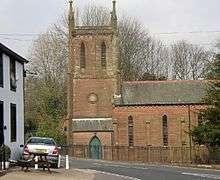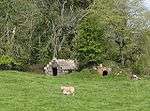Listed buildings in St. Bridget Beckermet
St. Bridget Beckermet is a civil parish in the Borough of Copeland, Cumbria, England. It contains ten buildings that are recorded in the National Heritage List for England. Of these, two are listed at Grade I, the highest of the three grades, three are at Grade II*, the middle grade, and the others are at Grade II, the lowest grade. The parish contains the village of Calder Bridge and the surrounding countryside. The most important building in the parish is the former Calder Abbey; the ruins of this and associated structures are listed. The other listed buildings are houses and associated structures, and churches.
Key
| Grade | Criteria[1] |
|---|---|
| I | Buildings of exceptional interest, sometimes considered to be internationally important |
| II* | Particularly important buildings of more than special interest |
| II | Buildings of national importance and special interest |
Buildings
| Name and location | Photograph | Date | Notes | Grade |
|---|---|---|---|---|
| Ruins of the monastic church and east range, Calder Abbey 54°26′38″N 3°27′53″W / 54.44402°N 3.46474°W |
Mid 12th century | The remains of the church consist of a nave, a transept, a tower at the crossing, and a chancel. The west doorway is in Norman style, and the rest of the church is Early English. The eastern range comprises parts of the chapter house, the dormitory, and an undercroft. The ruins are also a scheduled monument.[2][3][4] | I | |
| House incorporating monastic ruins 54°26′37″N 3°27′53″W / 54.44370°N 3.46486°W |
 |
Mid 12th century | The house dates from the 1780s, incorporating material from the monastery. the porch being added in 1859. The house is in stone, partly stuccoed, with a string course, an eaves cornice, and a hipped slate roof. The west front has two storeys with a cellar, and seven bays. It has a central Doric porch with a pediment, and above it is a Venetian window. The front facing the river has three storeys, ten bays, and a bay window. The windows are mullioned, and some also have transoms. To the east are single-storey courtyard buildings.[5] | I |
| St Bridget's Church, Beckermet 54°26′26″N 3°31′13″W / 54.44045°N 3.52032°W |
 |
Medieval | Alterations were made to the church in the 17th century. It is in roughcast stone and has a slate roof with coped gables. It is a small church consisting of a nave and a chancel, with a bellcote on the west gable. In the nave are three-light mullioned windows. The west doorway has a plain surround.[6][7] | II* |
| Gatehouse, Calder Abbey 54°26′39″N 3°28′01″W / 54.44404°N 3.46706°W |
— |
14th century (probable) | The gatehouse has been altered and later used for other purposes. It is in stone with quoins and a slate roof with coped gables. There two storeys and two bays. Each gable end contains a pointed double-chamfered wagon arch. The east arch has chamfered imposts and plinths; the west arch is blocked.[8][9] | II* |
| Sella Park 54°26′07″N 3°29′27″W / 54.43529°N 3.49093°W |
— |
14th century | A pele tower was incorporated into this later 17th-century country house, which was restored in the 19th century. It is in stone, mainly roughcast and has quoins and a slate roof with coped gables. There are three storeys, a double-pile plan, and a front of seven bays. The windows are mullioned or mullioned and transomed.[10][11] | II |
| Cauder House 54°26′25″N 3°28′46″W / 54.44017°N 3.47931°W |
— |
1727 | A roughcast stone house with a slate roof. It has two storeys, three bays, and sash windows. The central doorway has a chamfered surround, a lintel with the date and an escutcheon, and a hood mould, above which is a medieval quatrefoil, probably from Calder Abbey.[10][12] | II |
| North Lodge and gate piers, Pelham House 54°26′22″N 3°28′56″W / 54.43956°N 3.48223°W |
— |
Early 19th century | The lodge is in ashlar with a hipped slate roof. It is in a single storey, and has a cruciform plan. On the west front is a recessed porch with Doric columns, and a fanlight above the door. On the north front are pilaster strips, a sash window, and a casement window, and on the east and south sides are 20th-century extensions. There are four rusticated gate piers; the outer piers have urn finials, and the inner piers have plinths with coats of arms.[8][13] | II |
| St Bridget's Church, Calder Bridge 54°26′26″N 3°28′44″W / 54.44068°N 3.47902°W |
 |
1842 | The church, by Edmund Sharpe, is in sandstone and has a slate roof with coped gables and a tiled ridge. It has a cruciform plan and consists of a nave, transepts, a chancel with a north vestry, and a west tower. The tower has diagonal buttresses, a west lean-to porch, a south pointed entrance, and a coped corbelled parapet with pinnacles. The windows are lancets.[8][14] | II |
| Fishing box 54°26′39″N 3°27′41″W / 54.44428°N 3.46146°W |
— |
Uncertain | The structure is on the bank of the River Calder in the grounds of Calder Abbey, and is constructed in stones taken from the abbey. It consists of a stone seat about 0.35 metres (1 ft 2 in) high. The south and west faces are built in re-used chamfered jamb stones, the east face and the top are in slabs, and the north face is open.[15] | II |
| The Monks' Oven 54°26′40″N 3°27′49″W / 54.44441°N 3.46356°W |
 |
Uncertain | The detached oven is in the grounds of Calder Abbey. It is constructed in stone; some of the external stone has been removed, exposing a mound of earth. There is a low semicircular doorway, and the interior is composed of stones making a domed structure.[8][16] | II* |
References
Citations
- ↑ Historic England
- ↑ Hyde & Pevsner (2010), pp. 213–216
- ↑ Historic England (1068638)
- ↑ Historic England (1007166)
- ↑ Historic England (1336040)
- ↑ Hyde & Pevsner (2010), p. 149
- ↑ Historic England (1086588)
- 1 2 3 4 Hyde & Pevsner (2010), p. 217
- ↑ Historic England (1086629)
- 1 2 Hyde & Pevsner (2010), p. 218
- ↑ Historic England (1336060)
- ↑ Historic England (1336061)
- ↑ Historic England (1086590)
- ↑ Historic England (1086589)
- ↑ Historic England (1086630)
- ↑ Historic England (1068656)
Sources
- Historic England, "Ruins of the monastic church and east range, St. Bridget Beckermet (1068638)", National Heritage List for England, retrieved 16 July 2016
- Historic England, "Calder Abbey, St. Bridget Beckermet (1007166)", National Heritage List for England, retrieved 16 July 2016
- Historic England, "House, incorporating monastic ruins and courtyard buildings adjoining to east, St. Bridget Beckermet (1336040)", National Heritage List for England, retrieved 16 July 2016
- Historic England, "Church of St Bridget, St. Bridget Beckermet (1086588)", National Heritage List for England, retrieved 16 July 2016
- Historic England, "Gatehouse to Calder Abbey, St. Bridget Beckermet (1086629)", National Heritage List for England, retrieved 16 July 2016
- Historic England, "Sella Park, St. Bridget Beckermet (1336060)", National Heritage List for England, retrieved 16 July 2016
- Historic England, "Cauder House, St. Bridget Beckermet (1336061)", National Heritage List for England, retrieved 16 July 2016
- Historic England, "North Lodge and gate piers to Pelham House, St. Bridget Beckermet (1086590)", National Heritage List for England, retrieved 16 July 2016
- Historic England, "Church of St Bridget, St. Bridget Beckermet (1086589)", National Heritage List for England, retrieved 16 July 2016
- Historic England, "Fishing box on the river bank to the east of the Abbey ruins, St. Bridget Beckermet (1086630)", National Heritage List for England, retrieved 16 July 2016
- Historic England, "The Monks' Oven, St. Bridget Beckermet (1068656)", National Heritage List for England, retrieved 16 July 2016
- Historic England, Listed Buildings, retrieved 16 July 2016
- Hyde, Matthew; Pevsner, Nikolaus (2010) [1967], Cumbria, The Buildings of England, New Haven and London: Yale University Press, ISBN 978-0-300-12663-1
This article is issued from Wikipedia - version of the 7/17/2016. The text is available under the Creative Commons Attribution/Share Alike but additional terms may apply for the media files.